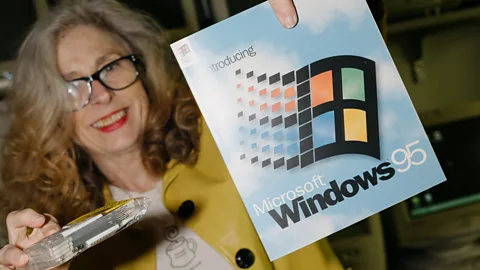Stuck in Time: The Enduring Legacy of Old Windows Systems
As technology continues to progress at an astonishing pace, some users find themselves tethered to outdated software and hardware. This intriguing phenomenon reveals the stubborn persistence of ancient Windows systems, which serve crucial roles even in today’s advanced technological landscape.
Recently, while heading to a medical appointment in New York City, I noticed an unexpected sight in an otherwise modern hospital: an elevator utilizing Windows XP, an operating system that first launched nearly 25 years ago. This unexpected glimpse into the past is a testament to Microsoft’s long-standing influence, especially as the company celebrates its 50th anniversary.
Microsoft’s enduring presence has led to significant success; the tech titan has been one of the world’s most valuable companies over the past five years. Now, as the tech landscape moves towards artificial intelligence, critics suggest that the legacy of Windows—often found in still-operational devices—represents a more complex aspect of the company’s history.
The Ubiquity of Windows’ Legacy
Microsoft’s reach into digital infrastructure is profound. Many sectors continue to rely on antiquated Windows software and equipment, which, despite their age, manage to function adequately. Lee Vinsel, a Virginia Tech professor, notes, “Windows has become the ultimate infrastructure; it’s woven into everything around us—and its longevity highlights Microsoft’s remarkable reach.”
A particularly surprising example of these old systems is found among ATM machines. Many still operate using legacy versions of Windows, including XP and even NT, released in 1993. Elvis Montiero, an ATM technician based in New Jersey, explains the hurdles to updating these machines, namely costs associated with software rewrites and regulatory compliance.
| Windows Version | Year Released | Usage Status |
|---|---|---|
| Windows 3.11 | 1993 | Used in train systems |
| Windows XP | 2001 | Still running on ATMs |
| Windows 2000 | 2000 | In use for large printers |
In Germany, a job posting by Deutsche Bahn inadvertently highlighted this issue when applicants were required to be proficient in Windows 3.11 and MS-DOS. A company spokesperson confirmed this necessity, citing the long service life of their trains and the reliability of these dated systems.
The Pitfalls of Aging Technology
However, working with such outdated technology presents its own set of frustrations. Psychiatrist Eric Zabriskie recalled his experience at the Department of Veterans Affairs, where he often waited 15 minutes just to boot up his outdated system, relaying the tediousness of using an operating system that’s clunky and reminiscent of the 1990s.
Scott Carlson, a woodworker in Los Angeles, faces similar challenges with his CNC machine still operating on Windows XP. He describes it as a “tank” that requires constant maintenance despite its reliance on an increasingly obsolete operating system.
Vinsel notes that one reason many organizations remain tethered to old tech is deferred maintenance. “Companies prioritize new features but neglect foundational updates, creating a dependency on legacy systems,” he states. This inflexibility not only stymies progress but also presents cybersecurity concerns as these systems become increasingly vulnerable.
An Alliance of Past and Present
Amid the prevalence of outdated systems also lies a passionate commitment to remembering and preserving early computing history. Dene Grigar, director of the Electronic Literature Lab at Washington State University, showcases fully functional computers dating back to 1977, illustrating how early digital art forms and literature have shaped culture.
As the tech world evolves, the stark contrast between cutting-edge innovations and enduring Windows systems will continue to be a topic of discussion. Whether viewed as relics or essential tools, these aging machines offer a fascinating glimpse into the legacy and future direction of the technology we rely on.

